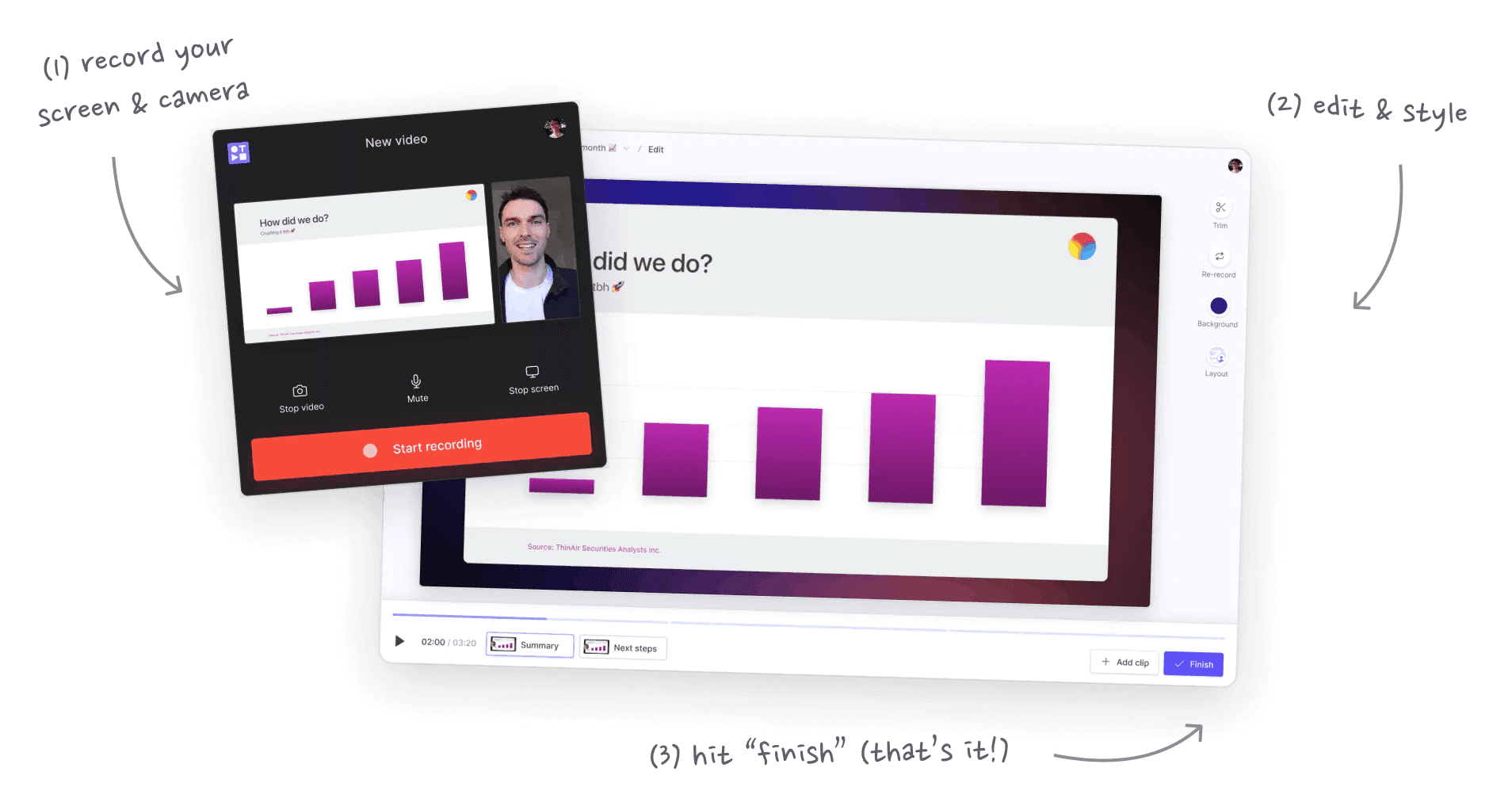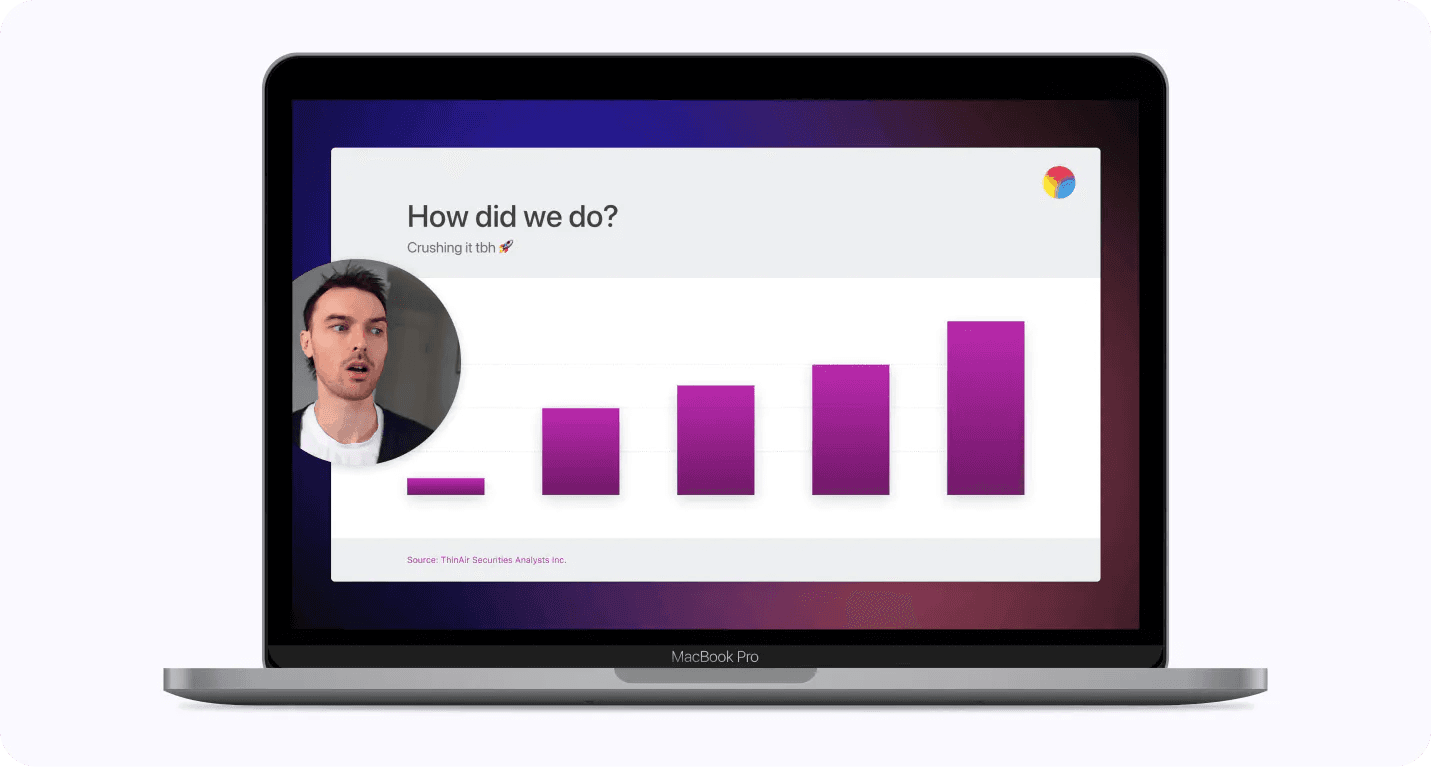July 7, 2023
10 Asynchronous Meeting Examples From Remote Workers

Dominic
We’ve been talking up asynchronous meetings in this blog series. But like any technology or product, the proof is in the pudding.
More specifically, the pudding being eaten by those remote workers who’ve been using asynchronous meetings and reaping the rewards.
In this post, we hear from 10 remote workers who’ve seen increases in productivity, free time, and more effective communication.
Before we hear from them, let’s make sure we’re familiar with the asynchronous terminology 👇.

What does working asynchronously mean?
Asynchronous work is when you complete your work, meetings, and communications without real-time collaboration.
That means removing synchronous communications like Zoom meetings and in-person meetings.
Instead, tools like Slack, Tella, and online document collaboration apps are used to allow online interactions without the need to meet in real-time or rely on instant messaging.
Read Later: Synchronous Meetings vs Asynchronous Meetings: What’s The Hype?
How do you collaborate asynchronously?
Working asynchronously includes both written communication and asynchronous video meetings. More often than not, it also includes the use of project/task management tools.
Asynchronous video
Perhaps the biggest asynchronous tool on the market is Loom. But that doesn’t mean you have to use Loom. No market that became a monopoly ever won customers over.
We tested and documented 20 Loom alternatives and even made our own (Tella). And we believe there’s room for all them to exist. Each one is built with specific users and use cases in mind.
The bare bones of all these tools is you can create asynchronous videos at the click of the button.
You can record your meeting content, add custom animations, borders, and captions, then send to everyone who needs to see it e.g. a sprint demo.
This could be a company all-hands when you have staff in different time zones and it’s hard to find a good time to meet.
It might be one-to-one feedback on a project where the other person is dedicating the day to deep work. An asynchronous video allows you to send your recorded feedback walking through changes for the final version.
Check out easy it is to use Tella in the video below:
When someone has watched the video, they can action their items, send a video response, or reply via a message.
Asynchronous messaging
When video isn’t needed, or when people prefer to type than talk, asynchronous messaging acts as a meeting using written communications.
You can “meet” in a Google Doc or a Slack channel. Just because there’s no video or audio, it doesn’t mean you aren’t collaborating.
You can host round-robin Slack meetings or use your Google Doc to list out tasks to complete in a set time. Who says meetings have to be the same?
Faizan Fahim, Marketing Manager at Breeze.io, says the biggest benefit of working asynchronously is it reduces the pressure to be online all the time.
“There’s no need to inform my team that I’m away from my keyboard or screen. Nobody expects me to reply instantly. Nor do I expect anyone else to reply immediately.”
The understanding and respect of personal time and deep work are major benefits when you get asynchronous meetings right.
How do you have an asynchronous meeting?
Using a tool like Tella, you can create asynchronous videos and send them to anyone who might be a meeting “participant”. The difference is they don’t need to be with you at the time you are creating the video.


Alan Cassinelli, Product Marketing Manager at Almanac, shares how his team has asynchronous meetings to collaborate on projects:
“The best part of it from a personal POV is that you can get info / take action on the parts of the meeting/doc that are relevant to you.
Instead of being in hour-long meetings where 10 minutes is relevant, we use async docs you can skim or see where you're tagged and get the info 10x faster.
Our marketing team recently developed a webpage entirely async over two weeks.
No real-time meetings at all.
We used an Almanac doc as a brief, created a mockup in Figma, left feedback via an asynchronous video tool, built it in Webflow, got it approved and published.
Four team members collaborated on it, from South Korea, to Portland, to LA, and NYC.
It was async perfection 👌”
What are the benefits of asynchronous communication?
Tamsin Lofthouse, a copywriter and founder of Fika Digital, says asynchronous communication gives people autonomy over their workload, allowing them to use a workstyle that's productive for them.
Generally, if you let people work the way they prefer, they’ll reward your trust with productivity.
I'm a *big* fan of asynch teams - it gives people autonomy over their workload, allowing them to use a workstyle that's productive for them. Not to mention the inclusivity benefits of empowering global teams through asynch work 👌🏼— Tasmin - Copywriter ✏️ (@GrandioseDays) March 2, 2022
Joe Manna, SEO Manager at Alyce, says asynchronous communication saves everyone from extra meetings. This, in turn, moves projects forward faster.
“Many people bear a heavy Zoom load, but asynchronous communication complements their deep focus cycles. Example: Our Marketing VP shares updates in a quick five-minute video instead of an hour-long meeting.”
Tina Donati, Content Marketing Lead at Alloy Automation, she went from a meeting-heavy team to asynchronous, and the biggest benefit was she noticed she accomplished WAY more in a week.
I went from a meeting-heavy team to asynchronous, and the biggest benefit for me was I noticed I was able to accomplish WAY more in a week. Before, I found myself working later because I had to catch up on work since the meetings took up most of my day.— Tina Donati (@Tina_Donati) March 2, 2022
Rupert Squires, Client Director at Information EXP, says asynchronous meetings mean meetings stick to the topic. If there’s nobody to take a meeting off on a tangent—wasting the time of everybody not involved in that tangent—meetings can be swift and stick to the agenda.
“Think about your typical Microsoft Teams meeting. How many of those stay on topic or expand to fill the time available?”
When synchronous meetings run over, there may be a knock-on impact for the rest of your day. If one meeting is overrun by 10 minutes, you might be 10 minutes late for the next one.
You could leave the meeting because time is up—but that feels a little rude. And when managers and senior staff are present, the likelihood of junior staff suggesting time is up and they need to be elsewhere is low.
Why do asynchronous teams perform better?
Alisha Shibli, Head of Marketing at Logo.com, has been working as part of an asynchronous team for the last few years. She points out three key areas where she’s seen her team perform better:
There's better project planning: there has to be if you want different time zones to work effectively.
There’s better and clearer communication: you can't go on and on about something, so you state the point for everyone to understand.
There’s more autonomy: there's no one to get on a call with so you think things through and figure it out without disturbing others.
Terence Rabe, Microsoft 365 Adoption & Change Manager at Transparity, says asynchronous collaboration removes the delay in feeding back information.
“We chat before and after meetings instead of waiting for the next bl**dy meeting to report back on actions. You do it in the post-meeting chat rather than waiting for next week’s update.”
Austin Church, Founder of Freelance Cake, says when you remove the synchronous element of meetings, asynchronous teams discover and solve process problems faster. This leads to more iterations and cycles in less time. It might cause stress at first but can lead to much tighter workflow and a much better tech stack.
On time zones, Austin points out that as one team member is winding down at the end of a work day, another will be winding up.
“I can assign my virtual assistant a task at 5pm EST and it will be finished when I wake up. That option feeds momentum. This is one of the most obvious benefits.”

Why asynchronous communication is the future
As phrases like burnout, always-on, and Zoom fatigue filter into our language, it’s important to take a break from real-time meetings.
While it might be impossible to remove them altogether, the people in this blog post have expressed how beneficial moving to asynchronous communication has been for them. And we’d be foolish not to try it out.
Nneka Otika, a Freelance Content Writer, says she will continue using asynchronous communication because it means being able to get work done when she’s most productive.
“Afternoons are my most productive time. Having an async option means I get to push meetings to the end of my day. I ship out deliverables to clients first thing in the morning for them, and end of day for me.
I'll keep using the async option because it makes sense for my business (solopreneur). I work best this way. Synchronous communication wrecks my productivity.”
At the end of the day, we want to enjoy our work as much as possible. Asynchronous meetings can do anything about your boss. But they sure can ease your workload.
For a perfect example of how asynchronous teams perform better, read how Open Scout onboarded 50 people all over the world with Tella.



